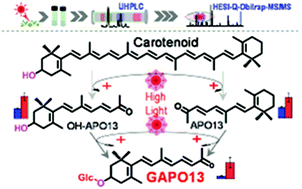An LC-MS profiling method reveals a route for apocarotene glycosylation and shows its induction by high light stress in Arabidopsis†
Abstract
Apocarotenoid glycosylation serves as a valve regulating carotenoid homeostasis in plants and may contribute to their response to photo-oxidative stress. However, an analytical method that allows comprehensive and sensitive profiling of glycosylated apocarotenoids (GAPOs) is still missing. We developed an efficient ultra-high performance liquid chromatography-high resolution-mass spectrometry (UHPLC-HR-MS) method to analyze 25 GAPOs present in carotenoid-accumulating E. coli cells and plant tissues. Optimized HR-heated-electrospray ionization (HESI)-MS parameters enabled, based on HR MS and tandem mass spectrometry (MS/MS) data, the identification of yet undescribed GAPOs from Arabidopsis, which include Glc-apo-11-carotenal (GAPO11), Glc-apo-13-carotenone (GAPO13), and their isomers. The identity of these compounds was confirmed by the transformation of deuterium-labelled non-hydroxylated carotene cleavage products into the corresponding GAPOs in planta. Quantitative analysis of GAPOs in Arabidopsis showed that the levels of Glc-cyclocitral (GAPO7), Glc-cyclocitral isomer I (GAPO7I), Glc-ionone (GAPO9), Glc-ionone isomer I (GAPO9I), Glc-apo-11-carotenal isomer I (GAPO11I), Glc-apo-13-carotenone (GAPO13), and Glc-apo-13-carotenone isomers (GAPO13I, GAPO13II, and GAPO13III) significantly increase after high light (HL) treatment. This treatment also led to an obvious increase in the levels of most carotene- and all xanthophyll-derived apocarotenoids detected in our system. Our work demonstrates for the first time that HL stress induces apocarotenoid glycosylation in Arabidopsis and unravels a novel plant metabolic pathway that leads from carotene cleavage products to GAPOs that are identical to xanthophyll derived GAPOs. Thus, our new approach allows sensitive and reliable profiling of GAPOs, which is crucial for understanding the function of apocarotenoid glycosylation in plants and its role in the acclimation to HL stress.



 Please wait while we load your content...
Please wait while we load your content...